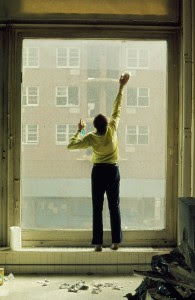John Hurrell – 19 May, 2009
This very focussed assortment of elegant black and white photos, videos, film, coloured slides, used tissue collections and inventories of glowing neon tubes effectively documented Apple's (the artist and the gallery) projects, making an exceptionally rivetting show, a display far too good (and significant) to be exposed to Wellington audiences only
Wellington
Billy Apple
Billy Apple: New York 1969-1973
Curated by Tina Barton
28 March - 17 May 2009
Held in Victoria University of Wellington’s Adam Art Gallery, Tina Barton’s unusual survey examined Billy Apple’s New York years: between his leaving of London for the States and the period leading up to the first of his two New Zealand tours in the mid-seventies. It looked closely at the preoccupations of his practice and the various activities of his non-profit Apple gallery, fitting in between the period discussed in Barton’s earlier The Expatriates show and the works discussed in Wystan Curnow’s now online (Auckland Art Gallery Quarterly) article on Apple’s 1975 tour.
It also partially overlapped with the 1974 Serpentine exhibition From Barrie Bates to Billy Apple 1960 - 1974 - if any of you are lucky enough to own that catalogue.
This Adam exhibition finished last Saturday, and was an understated warm up to new two exhibitions curated by Nicolaus Schafhausen and Zoe Gray about to open at Witte de With in Rotterdam. As one would expect from either Apple or Barton, the Wellington show was meticulously presented. Wall labels were kept to an absolute minimum, there were no distracting catalogue numbers beside the work, and the free photocopied pamphlet that listed works by name, indicated their positions via three maps. As the floor levels and stairwells at the Adam are quite complicated, you had to be on your toes to figure out the identity of the pieces.
What came through in Barton’s selection (from Apple’s extraordinarily extensive archives) was how the seemingly disparate transitive verbs that formed a basis for various art actions (like clearing, collecting, vacuuming or scrubbing) ended up being closely connected. The physical movements and byproducts from cleaning a room’s floor, or sweeping the roof of an apartment, suddenly acquired similarities to wiping a living human body. Terms like ‘gaseous discharge’ when applied to neon tubes became applicable as names for ‘residues’ for a nominated human body that was an artwork too.
These things regularly found parallels. Sometimes sustained, sometimes not. On one occasion a cotton bud or toilet tissue might be kept as art (by virtue of presenting a secretion from a larger and previous artwork such as Apple’s body, in another a soiled cloth from wiping windows would be thrown out in the rubbish; although they too could be an artwork’s byproduct - in terms of animated action, but not in bodily substance.
In the 2005 Expatriates catalogue Barton investigated the implications of Barrie Bates’ name change, and the consistency of his long interest in marketing and commerce. This recent show however was more about the other side of the coin - social relations and the body of the individual within those. There were some tensions that Barton might perhaps discuss in the planned publication, like the role of Apple in group activities when he (and only he) is a living art object. Though communal in context, his actions took on a different meaning from those of non-artworks like his then wife Jacki Apple, or friends like Jerry Vis or Geoff Hendricks.
Even for those reasonably familiar with Apple’s early work there were many unexpected surprises. One was a gorgeous 1968 film of flickering flames within differently coloured tubes of neon, exploring various linear configurations and close ups - with a soundtrack by Nam June Paik. Another was a project which showed Apple’s interest in going beyond his own personality, to do uncharacteristic things as instructed by an astrologer - like buying lottery tickets.
One of the highlights related to this was a video of his visit to a fortune teller who read his cards. In the unfolding discussion after her procedural analysis, we see Apple become confused and distressed because it is unclear whom the reading with its specific details pertains to - Billy Apple (b. 1962) or Barrie Bates (b.1935). He doesn’t like being filmed and asks for the camera to be turned off.
This very focussed assortment of elegant black and white photos, videos, film, coloured slides, used tissue collections and inventories of glowing neon tubes effectively documented Apple’s (the artist and the gallery) projects, making an exceptionally rivetting show, a display far too good (and significant) to be exposed to Wellington audiences only. One can only hope an Auckland venue like Te Tuhi, ARTSPACE, or AAG will slot it into their programme, and that the up and coming Witte de With shows will also return to Aotearoa to tour - just as the Stedelijk A Question of Faith McCahon exhibition did in 2003.
John Hurrell

 Two Rooms presents a program of residencies and projects
Two Rooms presents a program of residencies and projects Advertising in this column
Advertising in this column



This Discussion has 0 comments.
Comment
Participate
Register to Participate.
Sign in
Sign in to an existing account.